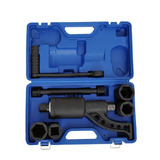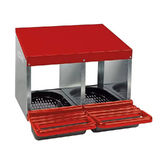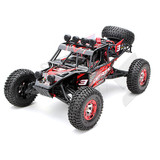How to properly transport, care for, and store your LiPo batteries
When they first arrived on the scene, LiPo batteries were shrouded in mystery. The technology was new, and the industry’s experience was limited. Initially, hobbyists were somewhat confused by LiPos, but now that the industry has enough experience under its belt, we can finally make some solid guidelines on LiPo use. LiPo batteries are expensive and volatile, but by understanding how to transport, charge, and care for them, everyone can utilize LiPo batteries to the fullest. For some insider advice on LiPo care, we reached out to Brandon Wilcox and Austin Else at MaxAmps to lend some expert input.
PROPER LIPO TRANSPORT
NO AIR … TECHNICALLY

Make sure that your batteries are properly padded in whatever box you’re using to ship them. You never know what will happen to that box while it’s being shipped!
The FAA does not permit flying with LiPo batteries, and that includes sending them through the mail by air. Although it does not seem to be heavily regulated, technically, the only way to transport LiPo batteries is on the road or by boat. It is a good idea to ship them by ground, rather than having them confiscated at the airport gate. When buying or selling LiPo packs, build in some extra time, and ship by ground only.
AVOID HEAT

Not only is it important to check the battery’s temperature before and after a run, but the environment in which your packs are stored also plays a vital role in battery life.
LiPos are sensitive to ambient temperatures and do not like being exposed to heat. The biggest factor in “mysterious” pack damage is storing packs in excessive heat. When transporting LiPos, keep them away from the heat. Do not leave them in the trunk on a hot sunny day. Keep them in a cool, dry location. Anything over 140°F can easily damage the packs.
TRANSPORT PACKS INDEPENDENTLY

Velcro-closed bags like this one are great for storing batteries in your pit bag.
Although it is rare, LiPo packs do have the ability to melt down on their own. Transport LiPos alone and in their own case. Never travel with the pack installed in the vehicle. This could prevent collateral damage if the pack goes bad. Some manufacturers even produce LiPo carrying cases, which are insulated and prevent LiPo mishaps from turning into disasters.
CHARGING RECOMMENDATIONS
USE A LIPO-SPECIFIC CHARGER
LiPo batteries are fundamentally unique in their charging needs, and thus require a specific kind of charger. Most LiPo chargers do charge other battery types, but not every charger is necessarily compatible with LiPos.
CHARGE BETWEEN 1C-4C

The amp charge rate is extremely vital when charging LiPo batteries. Always research how many “Cs” the pack is rated to charge at, and never deviate from that rate. Generally, higher-quality cells allow a higher “C” charge rate.
Choosing the correct charging rate is critical. Do some research, and find out how many “C’s” to charge the pack. According to Austin: “There are some LiPos on the market using low-grade cells; these packs should always be balanced charged at 1C to get the most life out of them. Higher-quality cells, like the ones used at MaxAmps can be safely balanced charged at 5C with no loss in performance or cell life.” Charging at 1C means that for every 1000mAh of capacity, you should charge the pack at one amp. So, at 1C, you would charge a 5000mAh pack at 5A, a 6500mAh pack at 6.5A, and so on. Charging at 2C multiplies the charge amps by two–so a 5000mAh pack, at 2C, should charge at 10A. Likewise 3C and 4C simply multiplies by three and four in the same fashion.
MONITOR THE CHARGE
Never leave a LiPo unattended while charging. Either the battery or charger could malfunction, resulting in blistering heat or combustion. Being there to unplug the charger or smolder-out a small fire is the difference between a small loss and a total catastrophe. Check the pack often. If it starts getting hot to the touch, unplug it immediately.
USE A BALANCER

Most LiPo packs contain multiple cells that work in sync. In a perfect world, all of the cells would charge and discharge equally, but unfortunately, that isn’t the case. To maintain consistent performance and durability, it is important to use a balancer when charging. The guys at MaxAmps say that using a balancer is extremely important, regardless of brand. It performs charging diagnostics to the individual cells in real time, resulting in a more consistent charge, cell to cell. Determine which kind of balancer the pack uses, and purchase one that supports the interface.
NEVER OVERCHARGE
Never attempt to overcharge a LiPo pack. Unlike NiCd batteries that like to be cooked, and NiMH batteries, which give frequent false peaks, “done” typically means “done” for a LiPo pack. Never restart a charging cycle unless you are confident that the charge ended prematurely.
CHARGE IN A SAFE LOCATION

The marketplace is now full of a variety of safe charging and transport devices. They are insulated and safeguard against charging mishaps, as well as protect the cells when traveling.
Choose a safe place, away from the vehicle and other valuables to setup the charger and battery. Place the battery on top of a LiPo case or similar, and give the charger plenty of room to breathe. Charging at high amps is a powerful task, and proper placement for both the battery and the charger should be considered.
ONGOING BATTERY CARE
UNPLUG PACKS

Always unplug the battery pack when not in use. This will help prevent accidentally over-discharging the cells, as well as preventing ESC damage and the possibility of a sudden “runaway” vehicle.
LiPos should never be left plugged in when not in use. Even though there isn’t a strong current draw, the battery does slowly discharge when plugged into the ESC with the power off. Only connect the battery when the vehicle is in use.
KEEP THEM DRY
As a general rule, water and electronics do not mix, and that usually applies to LiPo batteries. Some packs, however, are more suitable to water exposure. According to Austin, “Normally LiPos and water don’t mix, butMaxAmps.com LiPos are built using a unique process that makes them 100% waterproof for use in rain, snow, and all weather conditions.” Always refer to the instructions before bringing moisture into the equation.
AVOID OVER-DISCHARGING
LiPo packs should never be drained to nominal voltage. Draining the battery too far causes irreversible damage. Many ESCs offer a low-voltage cutoff, with LiPos in mind. When the ESC senses that the battery voltage reaches a critically low level, it cuts offpower, preventing damage from over-discharging the cell. Other methods of monitoring voltage are on-board monitors, alarms, and telemetry systems.
STORE WITH 50-70% CHARGE
LiPo packs should be stored with a partial charge. Check the battery’s instructions and determine the recommended voltage or capacity level for storage. Most manufacturers suggest storing LiPos between 50% and 70% charge capacity and voltage.
INSPECT FOR DAMAGE
LiPo packs should be regularly inspected for damage, as a small problem can result in a meltdown over time. A telltale sign of LiPo damage is swollen or puffed-up cells. This indicates irreversible damage and a potentially hazardous situation.
CHECK THE VOLTAGE MONTHLY

Use a battery monitor like Viper’s Pro Gauge, or simply hook up the battery to your charger, to check its voltage.
While LiPos hold their charge well in storage, they do slowly lose voltage over time. When storing packs long term, check the voltage and capacity monthly. If it dips below the recommended storage voltage, it is best to discharge the battery and add a fresh charge, or at the very least, top off the existing charge appropriately.
DISPOSE OF RUINED PACKS PROPERLY

When a good pack goes bad, the situation can get ugly in a hurry. If any puffing or ballooning is evident, discontinue use immediately, and plan on getting rid of the pack. Although lithium isn’t necessarily toxic, it is still recommended to recycle spent packs at a designated location.
When a pack no longer holds a charge, or the cells show signs of damage, it is best to dispose of it immediately. Check the manufacturer’s instructions on proper disposal, but most recommend discharging the cells completely with a low-drain device like a light, or using the discharge function on the charger. After the pack is discharged, drop it off at a cell phone store, Best Buy, or similar retailer who accepts spent battery packs.
WRAP-UP
As an industry, we have exponentially more knowledge about LiPo technology than just a few years ago. When they first arrived, LiPos were mysterious, and there was a lot of trial and error involved in proper care and handling. But now that LiPo dominates the scene, the knowledge base of the technology has improved dramatically. Although it is still best to stick to manufacturer recommendations, we can now say, without uncertainty, the best ways to utilize LiPos safely and effectively.







